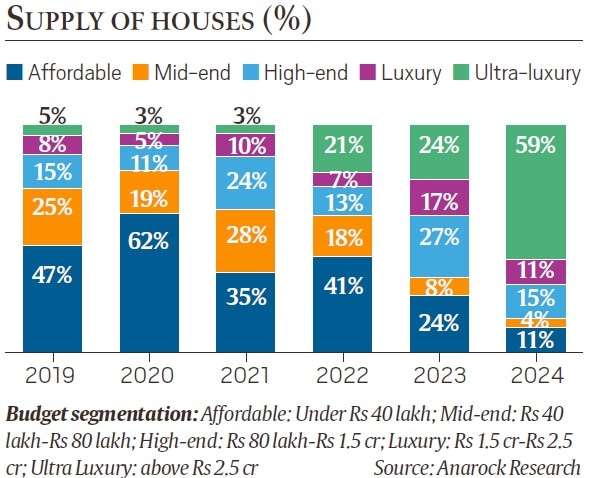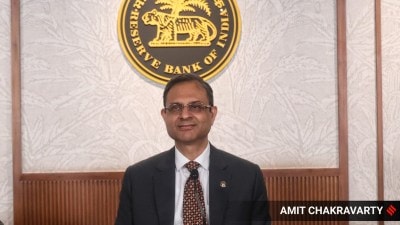Looking for affordable houses in Delhi-NCR? Here’s why it will be difficult.
Many of the potential buyers interested in the affordable segment work in the unorganised sector, which was severely hit by the pandemic
 The data indicates a strong and increasing need for housing in India's financial capital amid headwinds in global and domestic economies. (Representational image/Express)
The data indicates a strong and increasing need for housing in India's financial capital amid headwinds in global and domestic economies. (Representational image/Express)Affordable and mid-end housing sections – priced below Rs 40 lakh and between Rs 40 lakh to Rs 80 lakh, respectively – comprised 72% of the total residential units added to the inventory in Delhi-National Capital Region (NCR) in 2019. Five years later, this figure has shrunk to 15%. Specifically, the share of newly-launched houses priced below Rs 40 lakh dropped sharply from 62% in 2020 to 11% last year.
Meanwhile, units under luxury and ultra luxury sections – worth Rs 1.5 crore and above – have seen a massive jump, with 70% of such houses added to the market in 2024, up from only 13% in 2019. As many as 59% of such houses added to the market last year were worth more than Rs 2.5 crore, a report released by real estate consultancy Anarock, titled ‘NCR Real Estate – A Beacon of Growth and Opportunity’, stated.
Amid the reasons cited by the report for this development is the Covid-19 pandemic.

Many of the potential buyers interested in the affordable segment work in the unorganised sector, which was severely hit by the pandemic.
“This diminished their ability to buy a house,” said Prashant Thakur, Head of Research and Advisory, Anarock.
At the other end of the income spectrum, however, the report stated that people wanted bigger livable spaces post pandemic.
Further, Thakur said that many of the incentives offered to builders and buyers since 2015 in regard to affordable housing had expired in the last one or two years, making this sector unappealing to both groups.
“Next, rising costs for land acquisition and construction, and need to get approvals have led builders to prioritise higher-end projects over affordable housing, which typically has thin profit margins,” Thakur said.
The report also highlighted that the robust performance of capital markets in the recent past has led to an increased availability of disposable wealth among individuals, who consequently aspire to buy “superior” residences, which have certain amenities, architectural designs and a prestigious location.
As a result, many of the potential buyers of affordable houses have had to be content with renting, rather than purchasing a residence, Thakur said.
The residential real estate market in NCR spans over 55,000 sq km across Delhi and certain districts of Haryana, Uttar Pradesh, and Rajasthan.
According to the report, due to the pandemic as well as the result of a number of stalled projects, the NCR housing market had witnessed weakened demand, limiting new launches and stagnating price growth.
But government reforms, the key being the introduction of Real Estate Regulatory Authority (RERA), and a number of infrastructural projects like Eastern and Western Peripheral expressways, Dwarka Expressway and an expanding Metro network, have led to a revival in the region’s market, it added.

The report further said that residential property prices in NCR have surged by 81% over the last five years. Leading the price growth is Greater Noida, which witnessed a staggering 98% increase — from Rs 3,340 per sq ft in the first quarter (Q1) of 2020 to Rs 6,600 per sqft in Q1 2025.
The upcoming international airport in Jewar near Greater Noida and other infrastructure developments in the area have led to increased interest among homebuyers and investors, the report said.
Noida followed with a 92% jump in average property prices to Rs 9,200 per sq ft, while Gurgaon saw an 84% rise to Rs 11,300 per sq ft. Delhi continued to have the highest average property prices at Rs 25,200 per sq ft, though it posted a relatively modest increase of 38%.
It is important to note that the report only studies housing projects registered with the Real Estate Regulatory Authority (RERA), under which only projects either built on land bigger than 500 sq m or having more than eight apartments, have to be registered.
The report also leaves out residences built by the government. Only housing in the private organised sector, leaving out both government projects and individual plotted development — both of which are prevalent in the Capital — were studied. Therefore, it did not take into account the massive inventory of the Delhi Development Authority in the Capital.
Despite price hikes, NCR’s unsold housing inventory dropped 51% in the five-year period, the report noted. From around 1.73 lakh units in the first quarter of 2020, the inventory fell to about 84,500 units by Q1 2025. Noida recorded the sharpest fall in unsold stock — down by 72% — followed by Ghaziabad (58%) and Greater Noida (56%).
Inventory overhang—a key metric indicating how long it would take to clear current unsold stock—fell dramatically from 88 months in 2020 to just 17 months in 2025. The report also identified key growth corridors in NCR such as Sohna, New Gurgaon, Dwarka Expressway and Greater Noida West.













